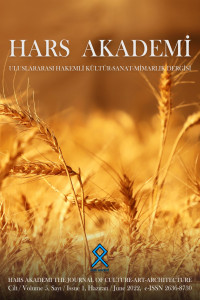Araştırma Makalesi
Yıl 2022,
Cilt: 5 Sayı: 1, 202 - 219, 30.06.2022
Öz
In the ancient Turkish tradition, due to the belief in the existence of another life after life, the construction of a cemetery was given importance. The tombs were built in the form of rooms or chambers, and mounds were formed by covering them with earth with the horse, weapons and other necessary equipment that the deceased will use in the next world. With the conversion of the Turks to Islam, this ancient tradition continued and took the name of the mausoleum. Yahya Kemal's understanding of "we live together with our dead", that is, the reconciliation of what is above and below the ground, is a continuation of our ancient tradition, and we have become one of the nations that can translate it into architectural language. This architectural language is a story in its evolution from cemetery to tomb and mausoleum.
The subject of our study is the tombs, which are the symbols of various periods of Turkish architecture, and the structures that have both a memory and a social function, and the unique "Twin Dome Tomb" is the subject. The aim of this study is to understand the spatial arrangement in tomb structures.
Anahtar Kelimeler
Kaynakça
- Ayverdi, Ekrem Hakkı (1966). İstanbul Mi'mârî Çağının Menşei Osmanlı Mimârisinin İlk Devri: 630-805 (1230-1402). İstanbul: İstanbul Fetih Cemiyeti, s. 332-335.
- Çağlıtütüncigil, E. (2017, 14-16 Ekim). “Türk Türbe Mimarisinde Ender Bir Örnek: Milas Ortaköy’de İkiz Türbe”, XIII. Ortaçağ ve Türk Dönemi Kazıları ve Sanat Araştırmaları Sempozyumu. (Ed. Kadir Pektaş vd.), s. 155-163. Denizli: Pamukkale Üniversitesi Sanat Tarihi Bölümü.
- Çakmak, Ş. (2017). ʺBergama, Tekkedere Köyü Sarı Dede Türbesi˝, Osmanlı Mirası Araştırmaları Dergisi, Cilt 4, Sayı 9, s. 69-84.
- Doğan, S. (2002). ʺKümbet˝. TDV İslam Ansiklopedisi, Cilt: 26, s. 547-550. İstanbul.
- Erdoğru, M. A. (1999, 8-10 Nisan). “Onaltıncı Yüzyıl Sonlarına Kadar Menteşe Sancağında Mevcut Vakıf Eserlere Genel Bir Bakış”, Uluslararası Osmanlı Tarihi Sempozyumu, s. 117-140. İzmir: Türk Ocakları İzmir Şubesi.
- Hafız Kadri (1332 [1913]). ʺMenteşe’de Menteşelilerden Sonraki Asar˝, Tarih-i Osmani Encümeni Mecmuası, C. 29, s. 313-315, İstanbul.
- https://parselsorgu.tkgm.gov.tr/#ara/cografi/37.409098424408064/27.838253080844883, [Erişim Tarihi: 04.12.2021].
- Kunduracı, O. (2007). Muğla-Yatağan Çevresindeki Türk Devri Mimarisi ve El Sanatları. Muğla: Muğla Valiliği Kültür Yayını, s. 45-46.
- Mülayim, S. (2002). ʺKubbe˝, TDV İslam Ansiklopedisi. Cilt: 26, s. 300-303. İstanbul.
- Orman, İ. (2012). ʺTürbe˝, TDV İslam Ansiklopedisi. Cilt: 41, s. 464-466. İstanbul.
- Yiğit, A. (2009). XVI. Yüzyıl Menteşe Livası Vakıfları, 338Numaralı Mufassal Evkaf Defteri H.970/M.1562. Ankara: Barış Platin Kitapevi, s. 65-66.
Yıl 2022,
Cilt: 5 Sayı: 1, 202 - 219, 30.06.2022
Öz
Kadim Türk geleneğinde yaşam sonrası başka bir hayatın varlığına olan inanç sebebiyle mezarlık inşasına önem verilmiştir. Mezarlar, ya oda veya odacıklar şeklinde inşa edilmiş ve mevta ile mevtanın öbür dünyada kullanılacağı at, silah ve lazım olan diğer gereçlerle üzeri toprakla örtülerek tümsekler oluşmuştur. Türklerin Müslüman olmasıyla birlikte bu kadim gelenek devam etmiş ve türbe ismini almıştır. Yahya Kemal’in “biz ölülerimizle bir yaşarız” anlayışı, yani toprağın altındakilerle üstündekilerin barışıklığı kadim geleneğimizin devamı olup, onu mimari dile aktarabilen milletlerden olmuşuz. Bu mimari dil mezarlıktan türbeye ve anıt mezara evirilişinde bir hikayesidir.
Çalışmamızın konusu Türk mimarisinin çeşitli dönemlerinin simgesi olan türbeler hem anı hem de sosyal işlevi olan yapılar olup, benzerine rastlanmayan ‘İkiz Kubbeli Türbe’ konu edilmiştir. Bu çalışmanın amacı mezar yapılarındaki mekânsal düzenlemeyi anlamak amaçlanmıştır.
Anahtar Kelimeler
Kaynakça
- Ayverdi, Ekrem Hakkı (1966). İstanbul Mi'mârî Çağının Menşei Osmanlı Mimârisinin İlk Devri: 630-805 (1230-1402). İstanbul: İstanbul Fetih Cemiyeti, s. 332-335.
- Çağlıtütüncigil, E. (2017, 14-16 Ekim). “Türk Türbe Mimarisinde Ender Bir Örnek: Milas Ortaköy’de İkiz Türbe”, XIII. Ortaçağ ve Türk Dönemi Kazıları ve Sanat Araştırmaları Sempozyumu. (Ed. Kadir Pektaş vd.), s. 155-163. Denizli: Pamukkale Üniversitesi Sanat Tarihi Bölümü.
- Çakmak, Ş. (2017). ʺBergama, Tekkedere Köyü Sarı Dede Türbesi˝, Osmanlı Mirası Araştırmaları Dergisi, Cilt 4, Sayı 9, s. 69-84.
- Doğan, S. (2002). ʺKümbet˝. TDV İslam Ansiklopedisi, Cilt: 26, s. 547-550. İstanbul.
- Erdoğru, M. A. (1999, 8-10 Nisan). “Onaltıncı Yüzyıl Sonlarına Kadar Menteşe Sancağında Mevcut Vakıf Eserlere Genel Bir Bakış”, Uluslararası Osmanlı Tarihi Sempozyumu, s. 117-140. İzmir: Türk Ocakları İzmir Şubesi.
- Hafız Kadri (1332 [1913]). ʺMenteşe’de Menteşelilerden Sonraki Asar˝, Tarih-i Osmani Encümeni Mecmuası, C. 29, s. 313-315, İstanbul.
- https://parselsorgu.tkgm.gov.tr/#ara/cografi/37.409098424408064/27.838253080844883, [Erişim Tarihi: 04.12.2021].
- Kunduracı, O. (2007). Muğla-Yatağan Çevresindeki Türk Devri Mimarisi ve El Sanatları. Muğla: Muğla Valiliği Kültür Yayını, s. 45-46.
- Mülayim, S. (2002). ʺKubbe˝, TDV İslam Ansiklopedisi. Cilt: 26, s. 300-303. İstanbul.
- Orman, İ. (2012). ʺTürbe˝, TDV İslam Ansiklopedisi. Cilt: 41, s. 464-466. İstanbul.
- Yiğit, A. (2009). XVI. Yüzyıl Menteşe Livası Vakıfları, 338Numaralı Mufassal Evkaf Defteri H.970/M.1562. Ankara: Barış Platin Kitapevi, s. 65-66.
Toplam 11 adet kaynakça vardır.
Ayrıntılar
| Birincil Dil | Türkçe |
|---|---|
| Bölüm | MAKALELER |
| Yazarlar | |
| Yayımlanma Tarihi | 30 Haziran 2022 |
| Yayımlandığı Sayı | Yıl 2022 Cilt: 5 Sayı: 1 |


